The Interplay of Social Media and Conflict Management in Organizations
VerifiedAdded on 2023/06/05
|9
|2282
|487
Report
AI Summary
This report examines the increasing role of social media in business and its impact on conflict management. It defines social media and conflict management, explores their interrelation, and discusses the implications for business roles. The report highlights the benefits and potential confl...

Running head: SOCIAL MEDIA AND CONFLICT MANAGEMENT
SOCIAL MEDIA AND CONFLICT MANAGEMENT
Name of the student:
Name of the university:
Author note:
SOCIAL MEDIA AND CONFLICT MANAGEMENT
Name of the student:
Name of the university:
Author note:
Paraphrase This Document
Need a fresh take? Get an instant paraphrase of this document with our AI Paraphraser
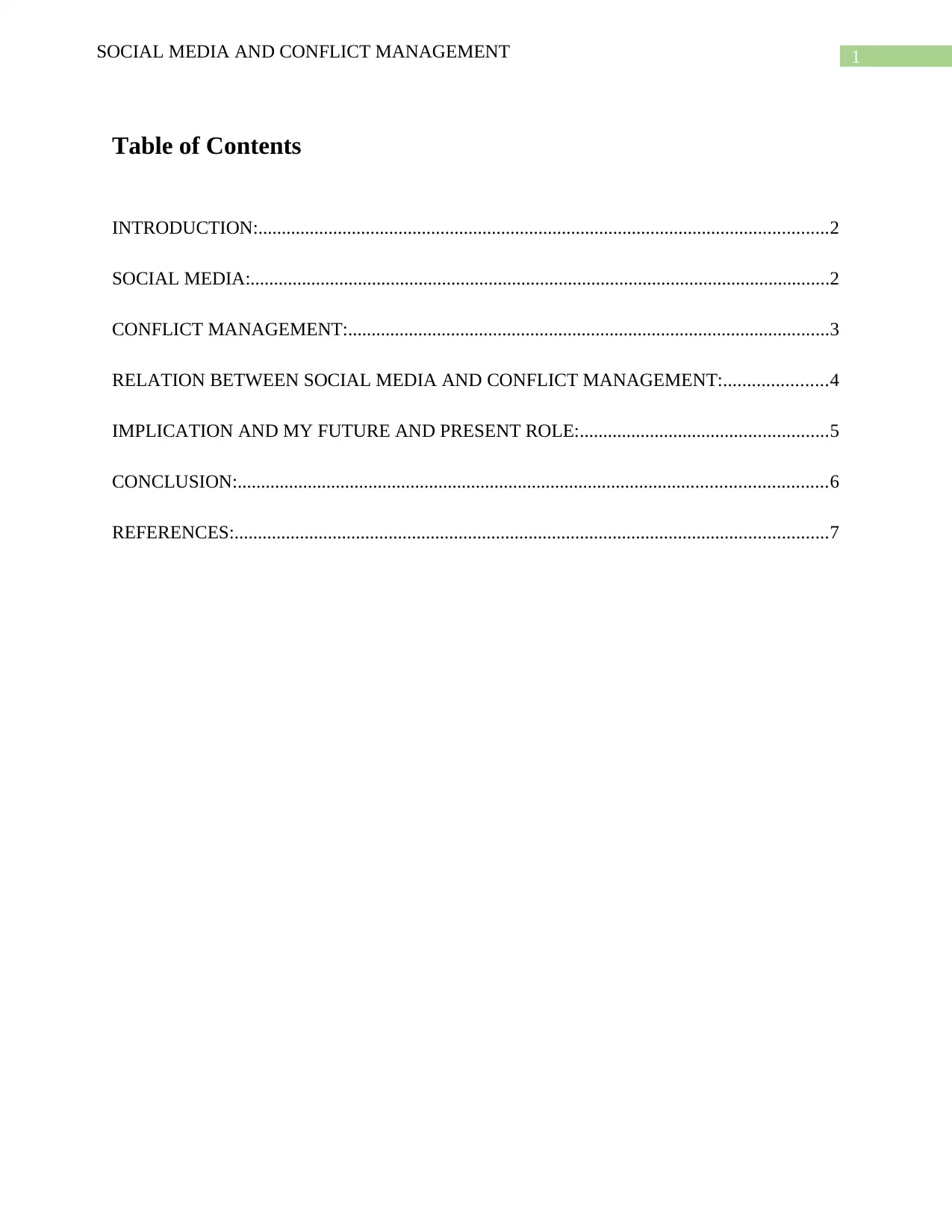
1SOCIAL MEDIA AND CONFLICT MANAGEMENT
Table of Contents
INTRODUCTION:..........................................................................................................................2
SOCIAL MEDIA:............................................................................................................................2
CONFLICT MANAGEMENT:.......................................................................................................3
RELATION BETWEEN SOCIAL MEDIA AND CONFLICT MANAGEMENT:......................4
IMPLICATION AND MY FUTURE AND PRESENT ROLE:.....................................................5
CONCLUSION:..............................................................................................................................6
REFERENCES:...............................................................................................................................7
Table of Contents
INTRODUCTION:..........................................................................................................................2
SOCIAL MEDIA:............................................................................................................................2
CONFLICT MANAGEMENT:.......................................................................................................3
RELATION BETWEEN SOCIAL MEDIA AND CONFLICT MANAGEMENT:......................4
IMPLICATION AND MY FUTURE AND PRESENT ROLE:.....................................................5
CONCLUSION:..............................................................................................................................6
REFERENCES:...............................................................................................................................7
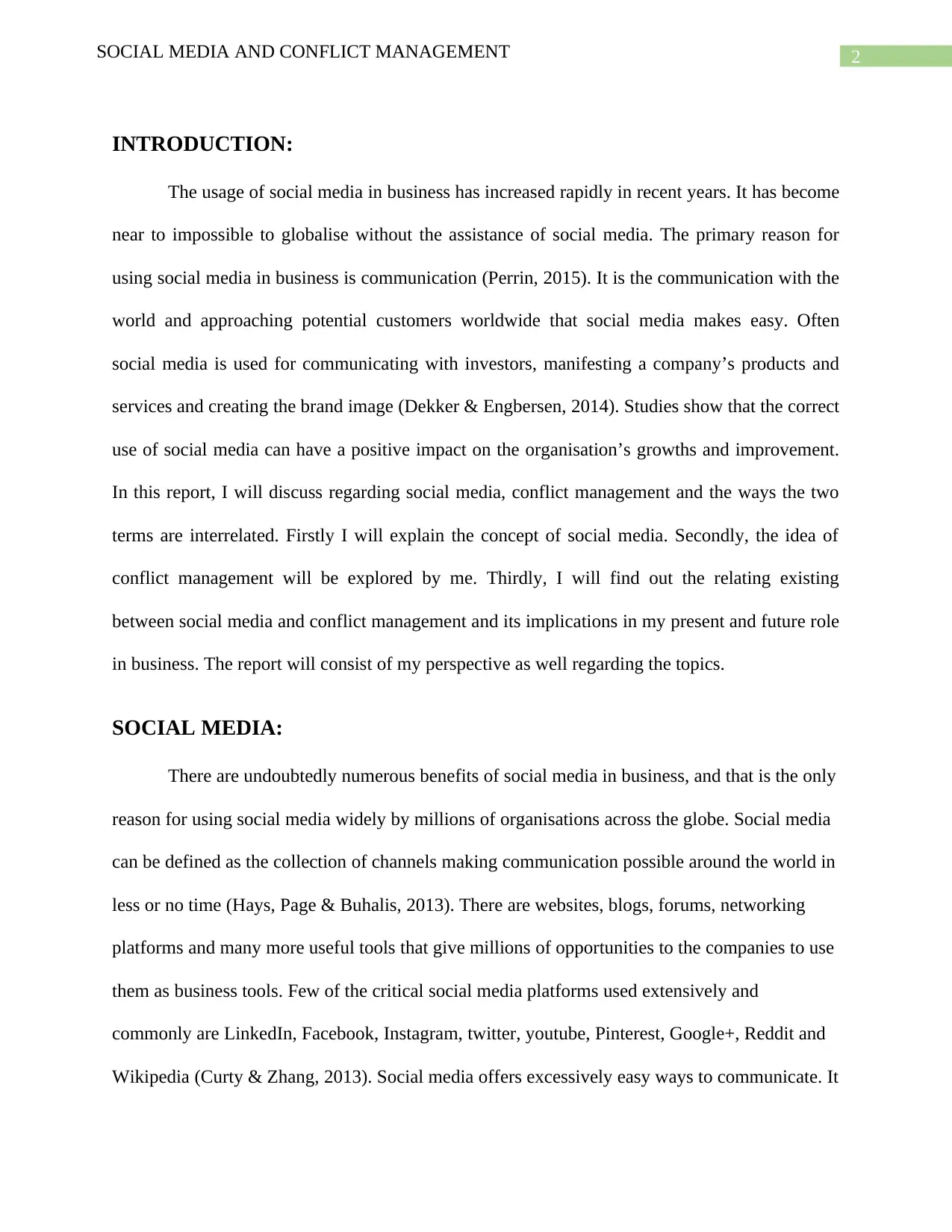
2SOCIAL MEDIA AND CONFLICT MANAGEMENT
INTRODUCTION:
The usage of social media in business has increased rapidly in recent years. It has become
near to impossible to globalise without the assistance of social media. The primary reason for
using social media in business is communication (Perrin, 2015). It is the communication with the
world and approaching potential customers worldwide that social media makes easy. Often
social media is used for communicating with investors, manifesting a company’s products and
services and creating the brand image (Dekker & Engbersen, 2014). Studies show that the correct
use of social media can have a positive impact on the organisation’s growths and improvement.
In this report, I will discuss regarding social media, conflict management and the ways the two
terms are interrelated. Firstly I will explain the concept of social media. Secondly, the idea of
conflict management will be explored by me. Thirdly, I will find out the relating existing
between social media and conflict management and its implications in my present and future role
in business. The report will consist of my perspective as well regarding the topics.
SOCIAL MEDIA:
There are undoubtedly numerous benefits of social media in business, and that is the only
reason for using social media widely by millions of organisations across the globe. Social media
can be defined as the collection of channels making communication possible around the world in
less or no time (Hays, Page & Buhalis, 2013). There are websites, blogs, forums, networking
platforms and many more useful tools that give millions of opportunities to the companies to use
them as business tools. Few of the critical social media platforms used extensively and
commonly are LinkedIn, Facebook, Instagram, twitter, youtube, Pinterest, Google+, Reddit and
Wikipedia (Curty & Zhang, 2013). Social media offers excessively easy ways to communicate. It
INTRODUCTION:
The usage of social media in business has increased rapidly in recent years. It has become
near to impossible to globalise without the assistance of social media. The primary reason for
using social media in business is communication (Perrin, 2015). It is the communication with the
world and approaching potential customers worldwide that social media makes easy. Often
social media is used for communicating with investors, manifesting a company’s products and
services and creating the brand image (Dekker & Engbersen, 2014). Studies show that the correct
use of social media can have a positive impact on the organisation’s growths and improvement.
In this report, I will discuss regarding social media, conflict management and the ways the two
terms are interrelated. Firstly I will explain the concept of social media. Secondly, the idea of
conflict management will be explored by me. Thirdly, I will find out the relating existing
between social media and conflict management and its implications in my present and future role
in business. The report will consist of my perspective as well regarding the topics.
SOCIAL MEDIA:
There are undoubtedly numerous benefits of social media in business, and that is the only
reason for using social media widely by millions of organisations across the globe. Social media
can be defined as the collection of channels making communication possible around the world in
less or no time (Hays, Page & Buhalis, 2013). There are websites, blogs, forums, networking
platforms and many more useful tools that give millions of opportunities to the companies to use
them as business tools. Few of the critical social media platforms used extensively and
commonly are LinkedIn, Facebook, Instagram, twitter, youtube, Pinterest, Google+, Reddit and
Wikipedia (Curty & Zhang, 2013). Social media offers excessively easy ways to communicate. It
⊘ This is a preview!⊘
Do you want full access?
Subscribe today to unlock all pages.

Trusted by 1+ million students worldwide

3SOCIAL MEDIA AND CONFLICT MANAGEMENT
provides exceptionally low cost methods of interaction and communication with audiences
(Lyon & Montgomery, 2013). With the help of social media, people can put forward their
perspective and opinion. Different social media has various features which attract people with its
unique features and qualities. Along with time people are increasingly becoming technology
driven since it is an easy, attractive and not expensive people are only increasing on social
platforms. Among the examples I provided, I am a holder of accounts in two to three platforms. I
have found myself reaching for internet and social media for most of the information I seek
daily. There have been times when I have given my personal view on social media on various
issues, opinions and perspectives through filling surveys, liking posts, or commenting on topics.
I have successfully made friends with unknown people and often ended up having disputes on
arguments. Therefore in my opinion, social media is a powerful tool with great potential that can
help you with your ideas or even create issues. Also, I agree to the point that it depends on the
way communication has been carried out which settles down as conflict or agreement.
CONFLICT MANAGEMENT:
Conflict management is the practice in an organisation that involves recognising issues
that have the tendency to create dispute and dealing with such disputes in a rational, balanced
and effective way (Head & Alford, 2015). It is often a limiting process that is used to limit the
negative aspects that can cause conflict. The primary aim of conflict management is an
enhancement of learning and group outcomes involving performance and effectiveness in any
organisation or company. Organisations that can have appropriate measures of conflict
management or any organisation that has adequately managed conflict can improve the overall
organisational performance (Jensen, 2017). Conflict resolution is a process involving
elimination, reduction and termination of various forms of conflict (Al Ramiah & Hewstone,
provides exceptionally low cost methods of interaction and communication with audiences
(Lyon & Montgomery, 2013). With the help of social media, people can put forward their
perspective and opinion. Different social media has various features which attract people with its
unique features and qualities. Along with time people are increasingly becoming technology
driven since it is an easy, attractive and not expensive people are only increasing on social
platforms. Among the examples I provided, I am a holder of accounts in two to three platforms. I
have found myself reaching for internet and social media for most of the information I seek
daily. There have been times when I have given my personal view on social media on various
issues, opinions and perspectives through filling surveys, liking posts, or commenting on topics.
I have successfully made friends with unknown people and often ended up having disputes on
arguments. Therefore in my opinion, social media is a powerful tool with great potential that can
help you with your ideas or even create issues. Also, I agree to the point that it depends on the
way communication has been carried out which settles down as conflict or agreement.
CONFLICT MANAGEMENT:
Conflict management is the practice in an organisation that involves recognising issues
that have the tendency to create dispute and dealing with such disputes in a rational, balanced
and effective way (Head & Alford, 2015). It is often a limiting process that is used to limit the
negative aspects that can cause conflict. The primary aim of conflict management is an
enhancement of learning and group outcomes involving performance and effectiveness in any
organisation or company. Organisations that can have appropriate measures of conflict
management or any organisation that has adequately managed conflict can improve the overall
organisational performance (Jensen, 2017). Conflict resolution is a process involving
elimination, reduction and termination of various forms of conflict (Al Ramiah & Hewstone,
Paraphrase This Document
Need a fresh take? Get an instant paraphrase of this document with our AI Paraphraser

4SOCIAL MEDIA AND CONFLICT MANAGEMENT
2013). Thomas and Kilmann have identified five styles of conflict management. The five types
of conflict management identified by Thomas and Kilmann are competing, compromising,
collaborating, avoiding and accommodating. Appropriate kind or levels of conflict can be
beneficial for businesses which are primarily the main aim of conflict management and not the
conflict resolution (Tidström, 2014). In the way a proper way of conflicting management can be
beneficial to an organisation in the similar way organisation not valuing the importance of
suitable conflict management can face risk in the business. Conflicts that are maintained by the
organisation’s conflict management can be in the internal environment or external environment.
Internal conflicts are the disputes that are within the organisation such as departmental disputes
or disputes among employees. External conflicts are the disputes of conflicts with other
organisations or with any other external body associated with the organisation such as media,
legislature and many more (Ratner et al., 2013). Like I mentioned under the social media section,
there have been situations where I have faced conflicts presenting my views and especially when
my perspectives are different than another person. However, reflecting on the experiences, I have
learned that it is often the way of communication and remembering a few key terms such as
accommodating, cooperating and avoiding that can be helpful in while managing the conflicts.
RELATION BETWEEN SOCIAL MEDIA AND CONFLICT
MANAGEMENT:
Social media is widely used in business for the easy and low cost methods that social
media provides. It has become of the most vital tool in business that cannot be ignored while
planning for the business’ growth and improvement (Hays, Page & Buhalis, 2013). Business is
involving more and more people, and social media gives the access to connect with millions of
people in a few seconds. Therefore, the use of social media has become mandatory in a business
2013). Thomas and Kilmann have identified five styles of conflict management. The five types
of conflict management identified by Thomas and Kilmann are competing, compromising,
collaborating, avoiding and accommodating. Appropriate kind or levels of conflict can be
beneficial for businesses which are primarily the main aim of conflict management and not the
conflict resolution (Tidström, 2014). In the way a proper way of conflicting management can be
beneficial to an organisation in the similar way organisation not valuing the importance of
suitable conflict management can face risk in the business. Conflicts that are maintained by the
organisation’s conflict management can be in the internal environment or external environment.
Internal conflicts are the disputes that are within the organisation such as departmental disputes
or disputes among employees. External conflicts are the disputes of conflicts with other
organisations or with any other external body associated with the organisation such as media,
legislature and many more (Ratner et al., 2013). Like I mentioned under the social media section,
there have been situations where I have faced conflicts presenting my views and especially when
my perspectives are different than another person. However, reflecting on the experiences, I have
learned that it is often the way of communication and remembering a few key terms such as
accommodating, cooperating and avoiding that can be helpful in while managing the conflicts.
RELATION BETWEEN SOCIAL MEDIA AND CONFLICT
MANAGEMENT:
Social media is widely used in business for the easy and low cost methods that social
media provides. It has become of the most vital tool in business that cannot be ignored while
planning for the business’ growth and improvement (Hays, Page & Buhalis, 2013). Business is
involving more and more people, and social media gives the access to connect with millions of
people in a few seconds. Therefore, the use of social media has become mandatory in a business
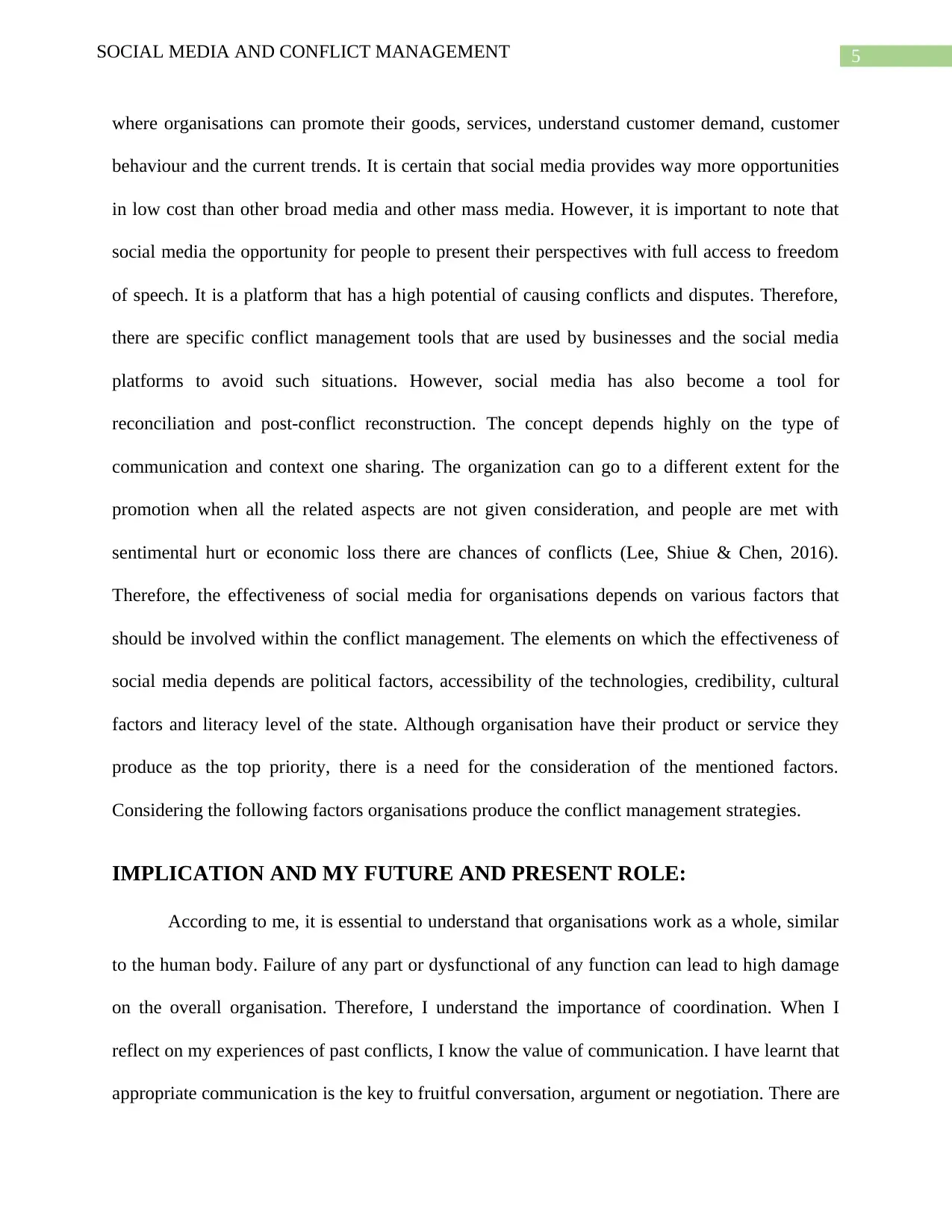
5SOCIAL MEDIA AND CONFLICT MANAGEMENT
where organisations can promote their goods, services, understand customer demand, customer
behaviour and the current trends. It is certain that social media provides way more opportunities
in low cost than other broad media and other mass media. However, it is important to note that
social media the opportunity for people to present their perspectives with full access to freedom
of speech. It is a platform that has a high potential of causing conflicts and disputes. Therefore,
there are specific conflict management tools that are used by businesses and the social media
platforms to avoid such situations. However, social media has also become a tool for
reconciliation and post-conflict reconstruction. The concept depends highly on the type of
communication and context one sharing. The organization can go to a different extent for the
promotion when all the related aspects are not given consideration, and people are met with
sentimental hurt or economic loss there are chances of conflicts (Lee, Shiue & Chen, 2016).
Therefore, the effectiveness of social media for organisations depends on various factors that
should be involved within the conflict management. The elements on which the effectiveness of
social media depends are political factors, accessibility of the technologies, credibility, cultural
factors and literacy level of the state. Although organisation have their product or service they
produce as the top priority, there is a need for the consideration of the mentioned factors.
Considering the following factors organisations produce the conflict management strategies.
IMPLICATION AND MY FUTURE AND PRESENT ROLE:
According to me, it is essential to understand that organisations work as a whole, similar
to the human body. Failure of any part or dysfunctional of any function can lead to high damage
on the overall organisation. Therefore, I understand the importance of coordination. When I
reflect on my experiences of past conflicts, I know the value of communication. I have learnt that
appropriate communication is the key to fruitful conversation, argument or negotiation. There are
where organisations can promote their goods, services, understand customer demand, customer
behaviour and the current trends. It is certain that social media provides way more opportunities
in low cost than other broad media and other mass media. However, it is important to note that
social media the opportunity for people to present their perspectives with full access to freedom
of speech. It is a platform that has a high potential of causing conflicts and disputes. Therefore,
there are specific conflict management tools that are used by businesses and the social media
platforms to avoid such situations. However, social media has also become a tool for
reconciliation and post-conflict reconstruction. The concept depends highly on the type of
communication and context one sharing. The organization can go to a different extent for the
promotion when all the related aspects are not given consideration, and people are met with
sentimental hurt or economic loss there are chances of conflicts (Lee, Shiue & Chen, 2016).
Therefore, the effectiveness of social media for organisations depends on various factors that
should be involved within the conflict management. The elements on which the effectiveness of
social media depends are political factors, accessibility of the technologies, credibility, cultural
factors and literacy level of the state. Although organisation have their product or service they
produce as the top priority, there is a need for the consideration of the mentioned factors.
Considering the following factors organisations produce the conflict management strategies.
IMPLICATION AND MY FUTURE AND PRESENT ROLE:
According to me, it is essential to understand that organisations work as a whole, similar
to the human body. Failure of any part or dysfunctional of any function can lead to high damage
on the overall organisation. Therefore, I understand the importance of coordination. When I
reflect on my experiences of past conflicts, I know the value of communication. I have learnt that
appropriate communication is the key to fruitful conversation, argument or negotiation. There are
⊘ This is a preview!⊘
Do you want full access?
Subscribe today to unlock all pages.

Trusted by 1+ million students worldwide
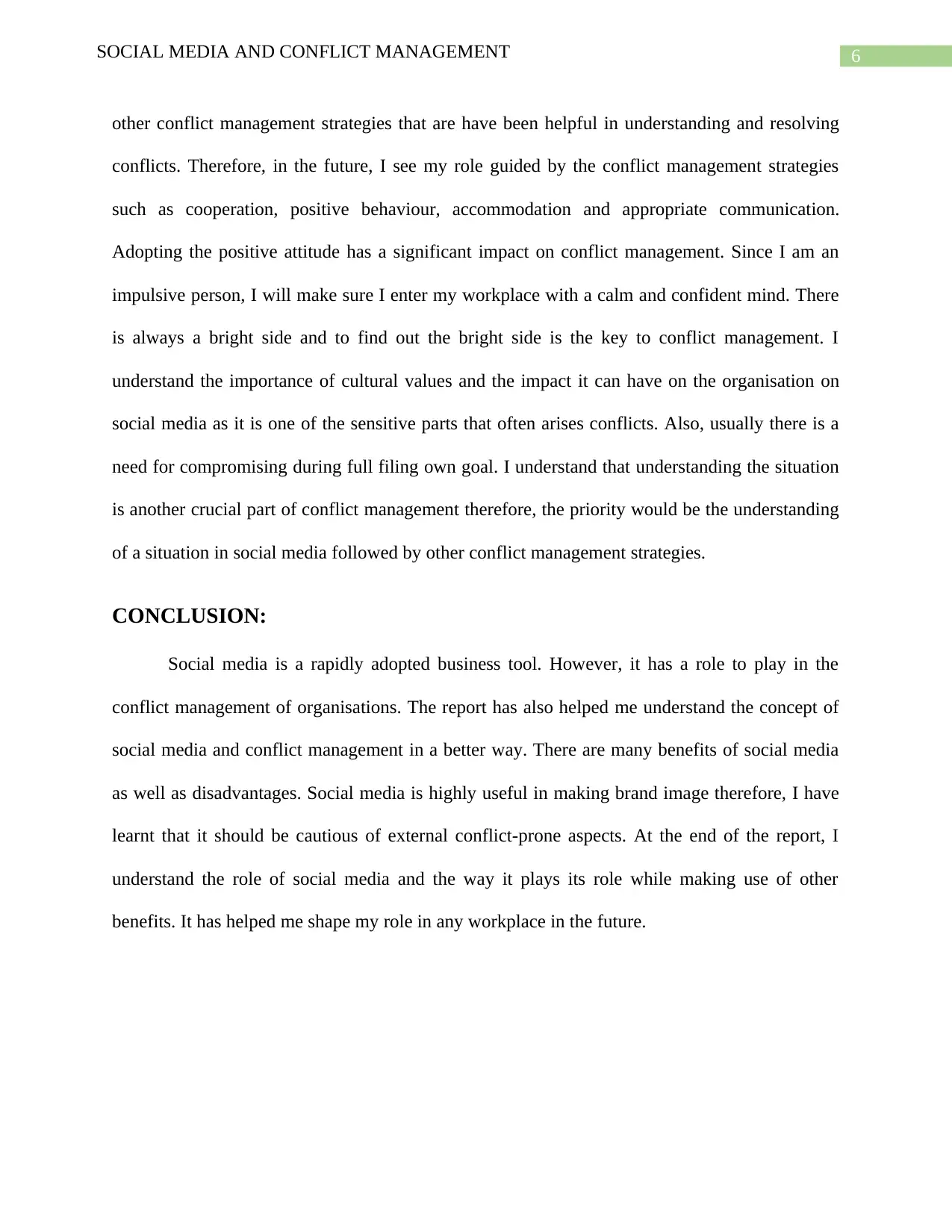
6SOCIAL MEDIA AND CONFLICT MANAGEMENT
other conflict management strategies that are have been helpful in understanding and resolving
conflicts. Therefore, in the future, I see my role guided by the conflict management strategies
such as cooperation, positive behaviour, accommodation and appropriate communication.
Adopting the positive attitude has a significant impact on conflict management. Since I am an
impulsive person, I will make sure I enter my workplace with a calm and confident mind. There
is always a bright side and to find out the bright side is the key to conflict management. I
understand the importance of cultural values and the impact it can have on the organisation on
social media as it is one of the sensitive parts that often arises conflicts. Also, usually there is a
need for compromising during full filing own goal. I understand that understanding the situation
is another crucial part of conflict management therefore, the priority would be the understanding
of a situation in social media followed by other conflict management strategies.
CONCLUSION:
Social media is a rapidly adopted business tool. However, it has a role to play in the
conflict management of organisations. The report has also helped me understand the concept of
social media and conflict management in a better way. There are many benefits of social media
as well as disadvantages. Social media is highly useful in making brand image therefore, I have
learnt that it should be cautious of external conflict-prone aspects. At the end of the report, I
understand the role of social media and the way it plays its role while making use of other
benefits. It has helped me shape my role in any workplace in the future.
other conflict management strategies that are have been helpful in understanding and resolving
conflicts. Therefore, in the future, I see my role guided by the conflict management strategies
such as cooperation, positive behaviour, accommodation and appropriate communication.
Adopting the positive attitude has a significant impact on conflict management. Since I am an
impulsive person, I will make sure I enter my workplace with a calm and confident mind. There
is always a bright side and to find out the bright side is the key to conflict management. I
understand the importance of cultural values and the impact it can have on the organisation on
social media as it is one of the sensitive parts that often arises conflicts. Also, usually there is a
need for compromising during full filing own goal. I understand that understanding the situation
is another crucial part of conflict management therefore, the priority would be the understanding
of a situation in social media followed by other conflict management strategies.
CONCLUSION:
Social media is a rapidly adopted business tool. However, it has a role to play in the
conflict management of organisations. The report has also helped me understand the concept of
social media and conflict management in a better way. There are many benefits of social media
as well as disadvantages. Social media is highly useful in making brand image therefore, I have
learnt that it should be cautious of external conflict-prone aspects. At the end of the report, I
understand the role of social media and the way it plays its role while making use of other
benefits. It has helped me shape my role in any workplace in the future.
Paraphrase This Document
Need a fresh take? Get an instant paraphrase of this document with our AI Paraphraser

7SOCIAL MEDIA AND CONFLICT MANAGEMENT
REFERENCES:
Al Ramiah, A., & Hewstone, M. (2013). Intergroup contact as a tool for reducing, resolving, and
preventing intergroup conflict: Evidence, limitations, and potential. American
Psychologist, 68(7), 527.
Curty, R. G., & Zhang, P. (2013). Website features that gave rise to social commerce: a historical
analysis. Electronic commerce research and applications, 12(4), 260-279.
Dekker, R., & Engbersen, G. (2014). How social media transform migrant networks and
facilitate migration. Global Networks, 14(4), 401-418.
Hays, S., Page, S. J., & Buhalis, D. (2013). Social media as a destination marketing tool: its use
by national tourism organisations. Current issues in Tourism, 16(3), 211-239.
Hays, S., Page, S. J., & Buhalis, D. (2013). Social media as a destination marketing tool: its use
by national tourism organisations. Current issues in Tourism, 16(3), 211-239.
Head, B. W., & Alford, J. (2015). Wicked problems: Implications for public policy and
management. Administration & Society, 47(6), 711-739.
Jensen, M. C. (2017). Value maximisation, stakeholder theory and the corporate objective
function. In Unfolding stakeholder thinking (pp. 65-84). Routledge.
Lee, J. C., Shiue, Y. C., & Chen, C. Y. (2016). Examining the impacts of organizational culture
and top management support of knowledge sharing on the success of software process
improvement. Computers in Human Behavior, 54, 462-474.
Lyon, T. P., & Montgomery, A. W. (2013). Tweetjacked: The impact of social media on
corporate greenwash. Journal of business ethics, 118(4), 747-757.
REFERENCES:
Al Ramiah, A., & Hewstone, M. (2013). Intergroup contact as a tool for reducing, resolving, and
preventing intergroup conflict: Evidence, limitations, and potential. American
Psychologist, 68(7), 527.
Curty, R. G., & Zhang, P. (2013). Website features that gave rise to social commerce: a historical
analysis. Electronic commerce research and applications, 12(4), 260-279.
Dekker, R., & Engbersen, G. (2014). How social media transform migrant networks and
facilitate migration. Global Networks, 14(4), 401-418.
Hays, S., Page, S. J., & Buhalis, D. (2013). Social media as a destination marketing tool: its use
by national tourism organisations. Current issues in Tourism, 16(3), 211-239.
Hays, S., Page, S. J., & Buhalis, D. (2013). Social media as a destination marketing tool: its use
by national tourism organisations. Current issues in Tourism, 16(3), 211-239.
Head, B. W., & Alford, J. (2015). Wicked problems: Implications for public policy and
management. Administration & Society, 47(6), 711-739.
Jensen, M. C. (2017). Value maximisation, stakeholder theory and the corporate objective
function. In Unfolding stakeholder thinking (pp. 65-84). Routledge.
Lee, J. C., Shiue, Y. C., & Chen, C. Y. (2016). Examining the impacts of organizational culture
and top management support of knowledge sharing on the success of software process
improvement. Computers in Human Behavior, 54, 462-474.
Lyon, T. P., & Montgomery, A. W. (2013). Tweetjacked: The impact of social media on
corporate greenwash. Journal of business ethics, 118(4), 747-757.
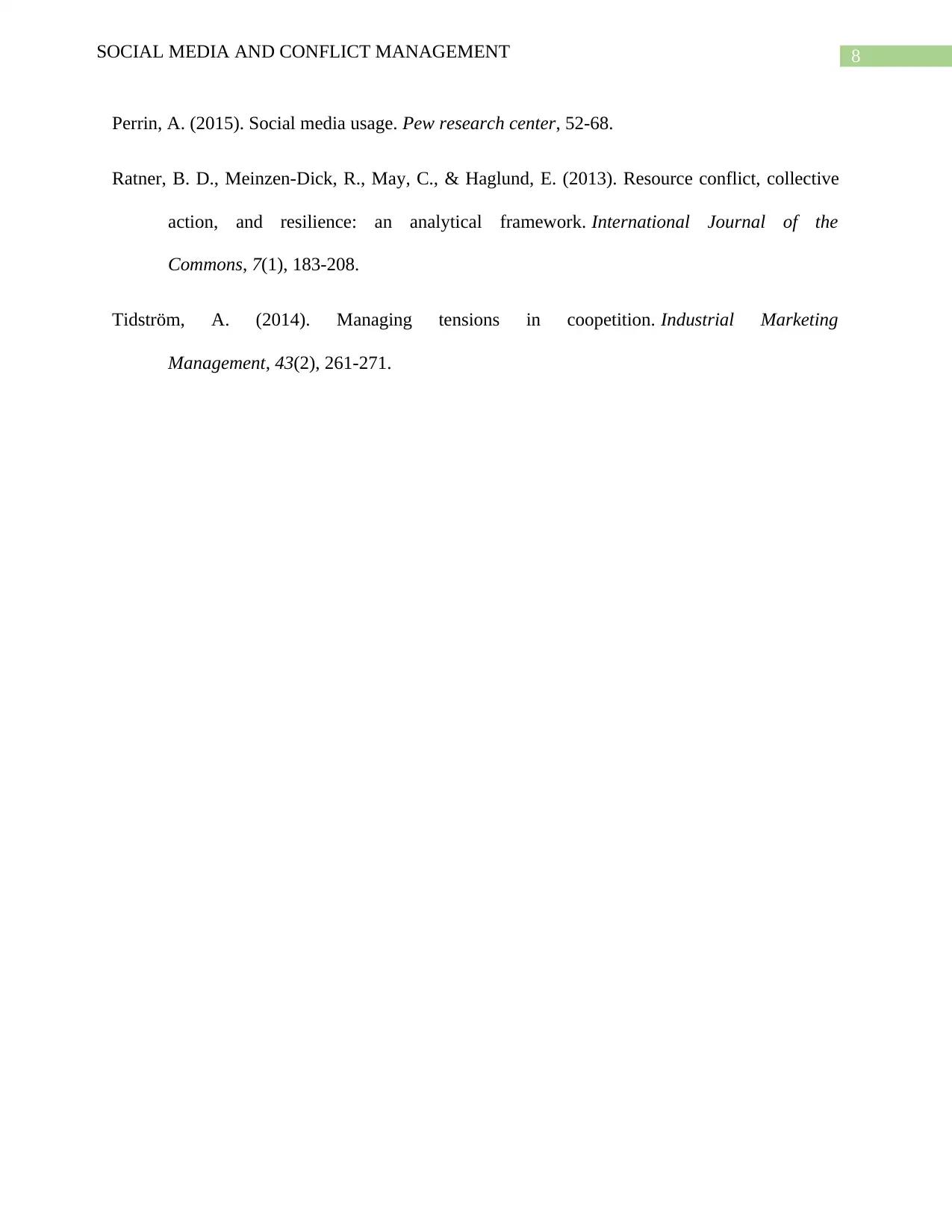
8SOCIAL MEDIA AND CONFLICT MANAGEMENT
Perrin, A. (2015). Social media usage. Pew research center, 52-68.
Ratner, B. D., Meinzen-Dick, R., May, C., & Haglund, E. (2013). Resource conflict, collective
action, and resilience: an analytical framework. International Journal of the
Commons, 7(1), 183-208.
Tidström, A. (2014). Managing tensions in coopetition. Industrial Marketing
Management, 43(2), 261-271.
Perrin, A. (2015). Social media usage. Pew research center, 52-68.
Ratner, B. D., Meinzen-Dick, R., May, C., & Haglund, E. (2013). Resource conflict, collective
action, and resilience: an analytical framework. International Journal of the
Commons, 7(1), 183-208.
Tidström, A. (2014). Managing tensions in coopetition. Industrial Marketing
Management, 43(2), 261-271.
⊘ This is a preview!⊘
Do you want full access?
Subscribe today to unlock all pages.

Trusted by 1+ million students worldwide
1 out of 9
Related Documents
Your All-in-One AI-Powered Toolkit for Academic Success.
+13062052269
info@desklib.com
Available 24*7 on WhatsApp / Email
![[object Object]](/_next/static/media/star-bottom.7253800d.svg)
Unlock your academic potential
© 2024 | Zucol Services PVT LTD | All rights reserved.





